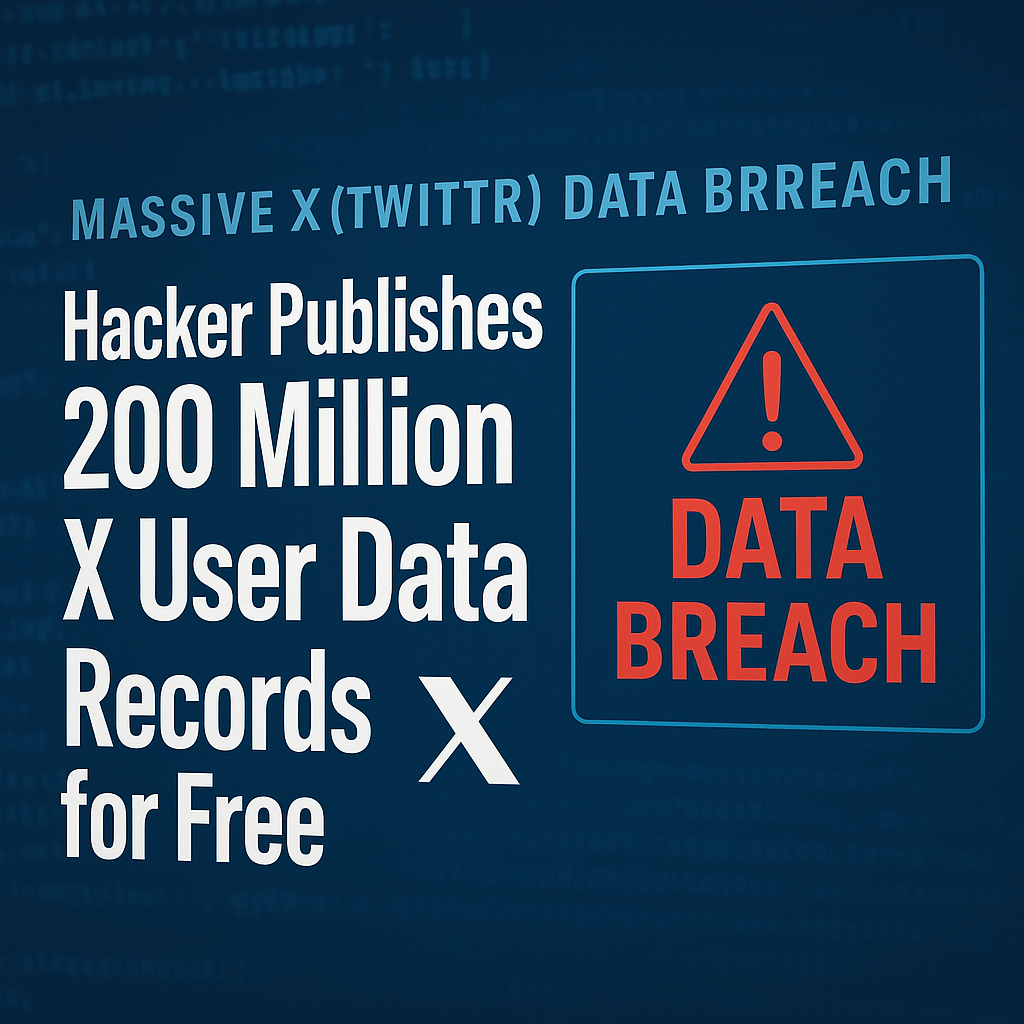Introduction
In one of the largest and most alarming data breaches of recent years, a hacker has published a database containing over 200 million X user records (formerly Twitter) — completely free on a popular hacking forum. This incident not only jeopardizes the privacy of millions of users worldwide but also reignites the urgent conversation around data security on social media platforms.
What Happened to X’s Data?
On April 1, 2025, Forbes reported that a hacker uploaded and shared a massive database allegedly containing over 200 million user records from X. The hacker made this data freely available, meaning anyone — including cybercriminals — can access it without paying a dime.
What Kind of Data Was Leaked?
Although the breach doesn’t appear to include passwords or extremely sensitive data like credit card numbers, the leaked database reportedly contains:
- Email addresses
- Usernames
- Full names
- Phone numbers (in some cases)
- Follower counts
- Account creation dates
- Verification status
- Other public and semi-private metadata
In addition to these records, the same source mentions that over 2.8 billion unique Twitter identifiers have also been exposed, which could be used to correlate user information at scale.
Is the Breach Authentic?
Cybersecurity experts have analyzed the sample data and confirmed its credibility. The data appears to originate from multiple prior vulnerabilities, including a known 2021 Twitter API flaw that allowed malicious actors to link email addresses and phone numbers to public Twitter accounts.
This vulnerability had been previously exploited in 2022 and 2023, but the sheer scale of this latest leak — and the fact that it’s been shared for free — makes it unprecedented.
Why This Matters for X Users
This breach places users at significant risk for a wide range of cyber threats, including:
Phishing Attacks
With access to real names, usernames, and email addresses, cybercriminals can craft highly convincing phishing emails to steal sensitive information like passwords or financial details.
Identity Theft
Even without passwords, hackers can combine leaked data to impersonate individuals and commit fraud.
Credential Stuffing
Users who reuse the same email and password combinations across platforms are especially vulnerable. While no passwords were leaked in this breach, the exposed emails could be used in broader credential stuffing attacks.
Doxxing and Harassment
The leak may enable bad actors to dox individuals, particularly public figures or controversial accounts, exposing them to harassment or worse.
Social Engineering
The information could be exploited to manipulate victims or people close to them, including employers or service providers, to gain unauthorized access or deliver malware.
What Has X Said About the Breach?
As of this writing, X has not issued a formal statement verifying the authenticity of the data or outlining their response plan. This silence has drawn criticism from the cybersecurity community, which expects greater transparency and responsibility from a platform with such global influence.
What Can X Users Do to Protect Themselves?
If you have an account on X, it’s crucial to take action now. Here’s what you should do:
- Enable Two-Factor Authentication (2FA)
Use an authenticator app like Google Authenticator or Authy instead of SMS. - Check If You’ve Been Compromised
Visit Have I Been Pwned and input your email address to see if it appears in the leak. - Update Your Password
Make sure it’s unique and not used on any other platform. - Beware of Suspicious Emails
Avoid clicking links or downloading attachments from unknown sources. - Monitor Your Accounts
Keep an eye on your bank statements and email for any unusual activity. - Consider Using an Alias for Future Accounts
Separate your public and private online identities whenever possible. - Stay Informed
Follow cybersecurity experts and reliable news sources for updates.
Advice for Businesses and Organizations
If your company maintains an X account or if your team uses the platform for brand engagement, this breach poses both reputational and operational risks. Take these steps:
- Update social media security policies.
Educate your staff about phishing and impersonation threats. - Enable strict access controls.
Use role-based access and MFA for all social accounts. - Monitor your brand’s mentions.
Set up alerts for suspicious activity or impersonation attempts. - Invest in threat intelligence and digital risk protection.
Use security platforms that track dark web leaks and credential dumps.
Industry-Wide Implications
This data breach highlights a harsh reality: even the most prominent tech companies can fall short in protecting user data. The broader impacts could include:
- Increased regulatory scrutiny over how social media companies store and manage data
- Greater demand for transparency and accountability from tech giants
- A shift toward decentralized platforms and privacy-first networks
- Growth in the use of cybersecurity tools by everyday users
Can This Happen Again?
Unfortunately, yes. Unless companies consistently audit their APIs, strengthen security protocols, and prioritize bug bounty programs, similar or even worse breaches could happen in the future.
Conclusion
The leak of 200 million user records from X is a wake-up call for everyone — from individuals to enterprise-level organizations. It underscores how vulnerable our online identities are and how important it is to take proactive steps to safeguard them.
This breach is a reminder that digital privacy is not guaranteed, even on platforms we use daily. It’s crucial to remain vigilant and informed in a world where your data can be weaponized in an instant.




